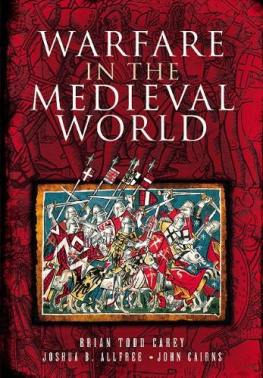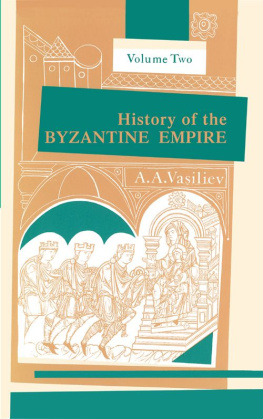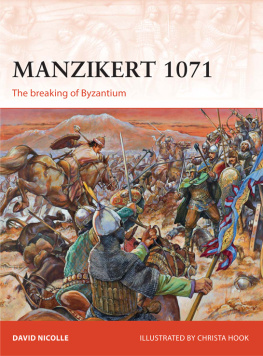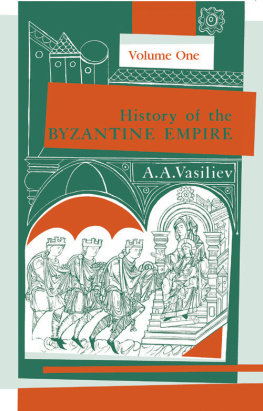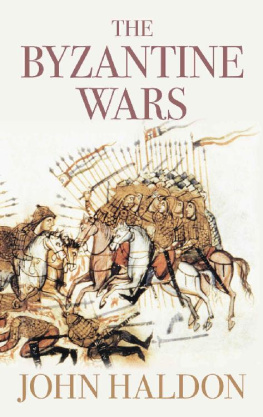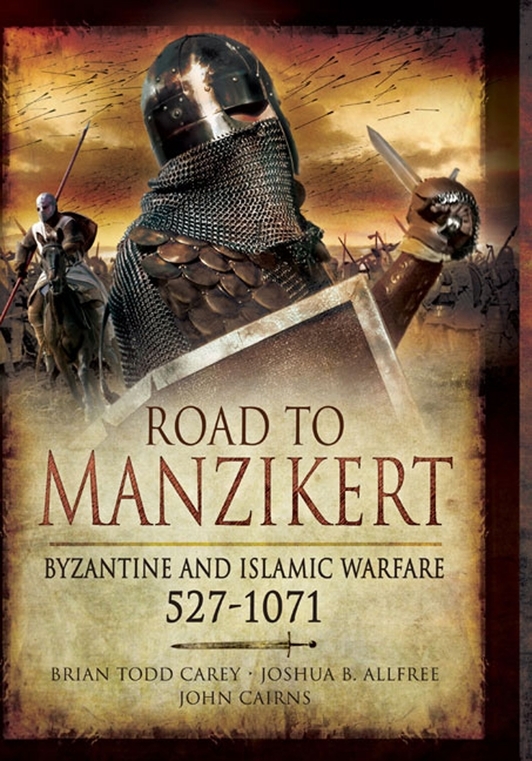In Manzikerts WakeThe Seljuk Invasion of Anatolia and the Origins of the Levantine Crusades
The Deaths of Romanus IV Diogenes and Alp Arslan
After placing his foot on the neck of the prone Byzantine emperor, Alp Arslan helped Romanus to his feet and asked him to sit next to him as an equal, reassuring him that he would be treated as a guest in the highest tradition of Islamic hospitality. For the next week Romanus remained a guest in the Seljuk pavilion as the two rulers worked out the conditions of his release. Alp Arslan demanded the surrender of Manzikert, Antioch, Edessa and Hieropolis, and the hand of one of the Byzantine rulers daughters for one of his own sons. The sultan also requested a ransom of ten million nomismata, but when Romanus explained that this sum was impossible to come up with due to the expense of the recent military expeditions, the sultan agreed to a million and a half nomismata gold pieces and an annual tribute of 360,000 nomismata.
Romanus nemesis, Caesar John Doukas, returned from exile in Bithynia on hearing the news of the Byzantine loss and, with the support of the palace Varangian Guard, proclaimed his weak-willed nephew Michael VII as sole emperor. Michaels mother, the regent Eudokia Makrembolitissa, was arrested and exiled to a convent she founded at the mouth of the Hellespont. Michael VII Doukas was quickly crowned in Hagia Sophia on 24 October 1071.
To make matters worse, the Byzantine losses at Bari and Manzikert in 1071 emboldened the enemies of Byzantium to challenge the empires resolve in the Balkans and Anatolia. A serious uprising in Bulgaria in 1072 required Byzantine military attention. Michael VII ordered Nikephoros Bryennios, now in the service of the Doukas family, to restore control, but at a heavy cost in men and material. In 1075, Pope Gregory VII sent his legates to crown Demetrius Zvonimir king of Croatia, pulling this kingdom into the Catholic orbit. Two years later, in 1077, Michael of Zeta received a papal coronation, further loosening Byzantiums grip in this region. Add to these developments Pecheneg and Magyar raiding, and Basil IIs achievement of a secure and friendly Balkan region was beginning to unravel.
In Anatolia, a military insurrection led by the Norman adventurer Roussel de Bailleul would alter the balance of power between the Seljuks and Byzantines. In 1073 , Michael sent a Byzantine army to deal with Seljuk raiding in Cappadocia and Roussel was the commander of a mixed force of Norman and Frankish mercenary cavalry. Once again, Roussel deserted the Byzantine army before the engagement with the Turks, who routed the Greek army near Caesarea. Roussel then set up an independent Norman state in the Armeniakon Theme in north-central Asia Minor with 300400 of his loyal men in a pattern similar to that used by Robert Guiscard in southern Italy after the Byzantine defeat at Bari. Enraged by this action, Michael sent an army commanded by his uncle Caesar John and the veteran strategos Nikephoros Botaneiates to deal with the rising Norman threat, but this Greek army was soundly defeated and John was captured. Roussel retaliated by marching across Bithynia to the Bosporus and burning the city of Chrysopolis across the strait from Constantinople. Roussel also proclaimed John emperor, apparently with the caesars approval, and his boldness attracted perhaps as many as 3,000 Frankish mercenaries to his standard. Distraught, Michael turned to the Seljuk Turks who were raiding in the eastern regions of Anatolia for assistance, hiring a large mercenary force operating in Bithynia under the command of the Seljuk emir Artuk to defeat the Normans. In return for their service, Michael was willing to cede territory held by the Seljuks to them permanently, greatly strengthening the steppe warriors hold on Anatolia. Artuk surprised Roussel at Metabole, defeating and capturing the Norman general and freeing John. But a ransom was raised by Roussels wife and the Norman adventurer resumed his activities.
In south-east Anatolia the Armenians, secure in their Taurus Mountains strongholds, violently threw off centuries of Byzantine rule and established various small fiefdoms in the region further south in Cilicia and northern Syria. However, one former Byzantine general, the Armenian Philaretos Brachamios who had protected Romanus lines of communication before the Manzikert campaign, consolidated these fledgling Armenian holdings into a sizeable state encompassing his base at Melitene and Edessa in Upper Mesopotamia, Tarsus in Cilicia, and Antioch in northern Syria. The core of his army was a contingent of 8,000 Franks supplemented by Armenian and Seljuk mercenaries. A pragmatic politician, Brachamios did not hesitate to call on the services of local Seljuk emirs to assist him with disobedient Armenian princes and is even rumored to have converted to Islam. This new Armenian state effectively ended Byzantine control over a large area of south-eastern Anatolia, although some of these cities continued to recognize nominal Byzantine authority or that of the Arab emirs of Syria while paying annual tribute to the victorious Seljuk Turks.
The new emperor, Michael VII, did not honour the treaty Romanus signed with Alp Arslan for the late emperors release, causing tension between the Great Seljuk Empire and Byzantium. Beginning in 1073, Turkoman raiders resumed their raiding into Anatolia from the north-east, but on this occasion Alp Arslan was unable to exert any influence on the marauders as he was killed in the late fall of 1072. After Manzikert, the sultan returned to the homeland of the Seljuk Turks, apparently to quell a rebellion encouraged by a former vassal in Transoxiana in what is now Turkestan. After crossing the Oxus River, Alp Arslan laid siege to a rebel fortress stubbornly defended by Yusuf al-Harani. Unable to take the fortress by force, Alp Arslan was able to convince Yusuf to open his gates by promising no harm would come to him and that he would retain his title and holdings. Yusuf was captured by the sultans bodyguard and brought before the Seljuk leader, ostensibly to be killed for his treasonous behavior. Yusuf was able to escape from his captors and fall upon Alp Arslan with a hidden dagger, severely wounding the sultan before the Seljuk bodyguard killed him. Alp Arslan died four days later on 24 November at the age of forty-one. The sultans body was taken back to the Seljuk capital of Merv by his son and successor, Malikshah, and his trustworthy vizier Nizam al-Mulk, to be buried in the land of his steppe warrior ancestors. The Valiant Lion had ruled over the Great Seljuk Empire of Iran for nearly a decade, during which time he had consolidated the conquests of his predecessors Chaghri and Toghril, humbled the Byzantine Empire on the field of battle, and captured and released its basileus .
When Malikshah (r.10721092) succeeded his father as sultan he was still a minor and under the guardianship of Nizam al-Mulk. Malikshahs twenty-year reign would witness the expansion of the Great Seljuk Empire through the annexation of vassal Marwanid Emirate in south-eastern Anatolia and the Karakhanid Empire in Central Asia. By the end of Malikshahs reign his empire stretched from Arabia to the edge of India and included nearly all of the Muslim territories in Asia.
The Byzantine Civil War and the Rise of the Sultanate of Rum
In 1077, two Byzantine generals rebelled nearly simultaneously against the reign of Michael VII. Nikephoros Bryennios, who had fought with distinction at Manzikert and put down the Bulgarian revolt in 1072, becoming governor of Dyrrachium. When he learned that the emperors eunuch counsellor had placed his name on a list for assassination, Bryennios raised the banner of revolt in November 1077 and marched on his native city of Adrianople where he was proclaimed emperor. Gathering the western armies, a week later he and his troops were camped beneath the Theodosian Walls of Constantinople.




